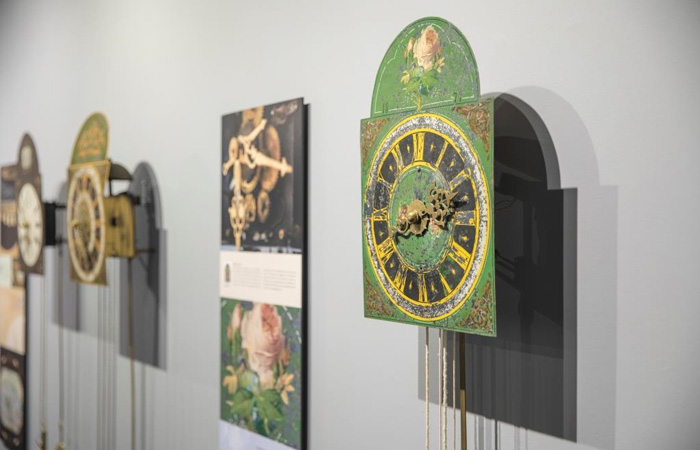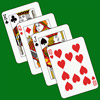Village News
Sharing the Stories of Artefacts and Living Objects

An exhibit like The Art of Mennonite Clocks, currently on display in our Gerhard Ens Gallery, doesn’t happen without a lot of cooperation. This exhibit has married the strengths of two organizations, Mennonite Heritage Village (MHV) and Kroeger Clocks Heritage Foundation (KCHF), and two ways of looking at objects: as artefacts and as living objects.
Approximately half the clocks in the exhibition have come from MHV’s collection of artefacts. The other half have been loaned to MHV by organizations, including The Manitoba Museum and Mennonite Heritage Archives, and by individuals in the community. Most of the clocks from this latter category were loaned through KCHF.
Artefacts are objects that are preserved, stored, and exhibited as a part of a museum’s official collection. If you’ll excuse what becomes a pun in this particular case, they are objects upon which time has essentially stopped. The state of an artefact when it enters a museum’s collection is usually the state in which it’s kept. Of course, preventative conservation measures are put in place to prevent further deterioration and to stabilize the object, but scratches in the paint or dents in metal, for example, are for the most part left as is. This is because they stand as evidence of an object’s past, as markers of its experience, and they speak to its history in a way that repairing them would erase. So in our exhibit you will see clocks that might be bent, marked, or in some other way no longer in pristine condition. These clocks bear the marks of their history.
A Mandtler clock in MHV’s collection is a good example of how the imperfections in an object can be more important than its restoration to perfect condition. The story told by the donor at the time this clock was donated to our museum is that the scratches marring the clock’s face were made by anarchists’ swords during a home invasion in the Soviet Union prior to the family’s emigration.
Artefacts in a museum’s collection also change legal ownership from individuals to the museum. They receive a high level of protection as part of the collection, with strict environmental, access, and care restrictions placed on them, and they become accessible to the public in ways that objects held in private homes don’t typically have the opportunity to be. As MHV’s curator, I feel honoured when I get to sit down with individuals who are donating items to our collection and am entrusted with not just the item itself, but also with the history the item has carried for that person or that family, sometimes for generations. I count these interactions with donors as one of the most fulfilling parts of my job and some of my key reasons for doing what I do.
In contrast to museum artefacts, objects kept in people’s homes in the community continue to accumulate a history. They continue to have a life of their own. The clocks loaned from the community for our current exhibit are part of the life in the houses from which they come, part of the story of their owners’ lives. These living objects don’t have the restrictions placed on them that artefacts in museum collections do, so they are free to be repaired, painted over, or otherwise altered – sometimes for better and sometimes perhaps not. Visitors to The Art of Mennonite Clocks will see wonderful examples of beautifully repaired clocks, like Ernest Braun’s Werder clock (see last week’s “Village News” column), as well as examples of more debatable restoration choices. Even their temporary presence in this exhibit becomes a part of the history of these living objects in a way that’s quite different from artefacts held in museum collections. These community clocks come from private homes and are sharing a family history in a very public way. These objects will undoubtedly be deeply missed in family homes during their time in our exhibit, so it is quite special that they’ve been loaned to us. We are grateful to those individuals who have contributed so richly to our exhibit by sharing their clocks with the public in this way.
As we heard from the stories that were told at our exhibit opening a few weeks ago, Mennonite wall clocks are a unique artefact, with a full and rich history. MHV, with our collected artefacts, and KCHF, with the stories and visual records in its virtual collection, both have a role in helping to preserve this history. We hope to do so through our current exhibit as we highlight the role which these unique objects played in the span of Mennonite history. As visitors will also see in the exhibit, there is still much more to be done in terms of research on individual clocks and on this group of objects as a whole. So in addition to generating interest in the clocks themselves, we hope that our exhibit will also spur research into the material and social history surrounding these artefacts and their various makers.
Our goal with this exhibition is that visitors experiencing The Art of Mennonite Clocks will see these clocks as bearers of a long history and as works of art, inside and out, in their own right.




